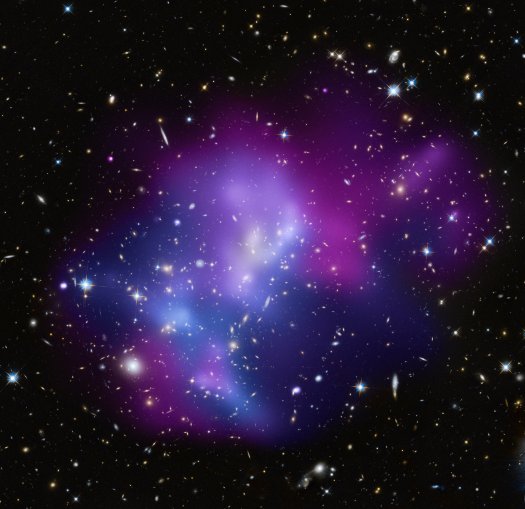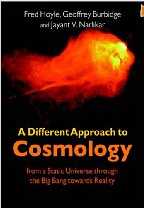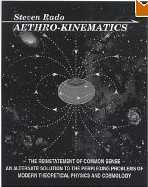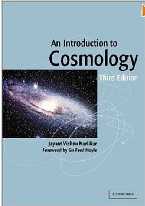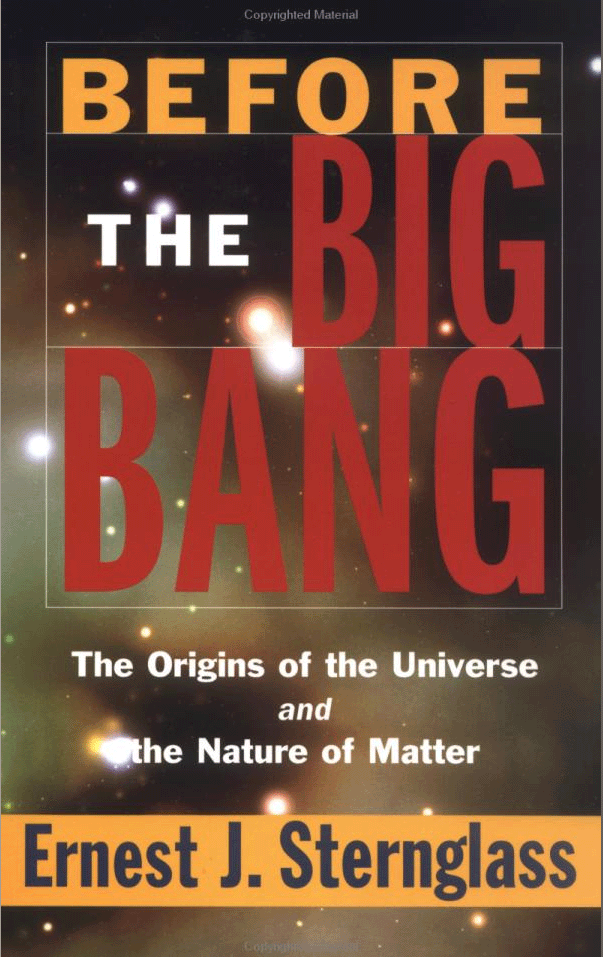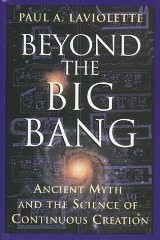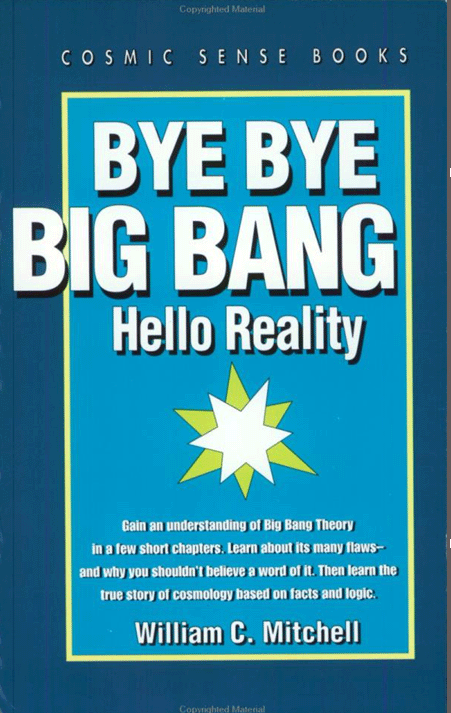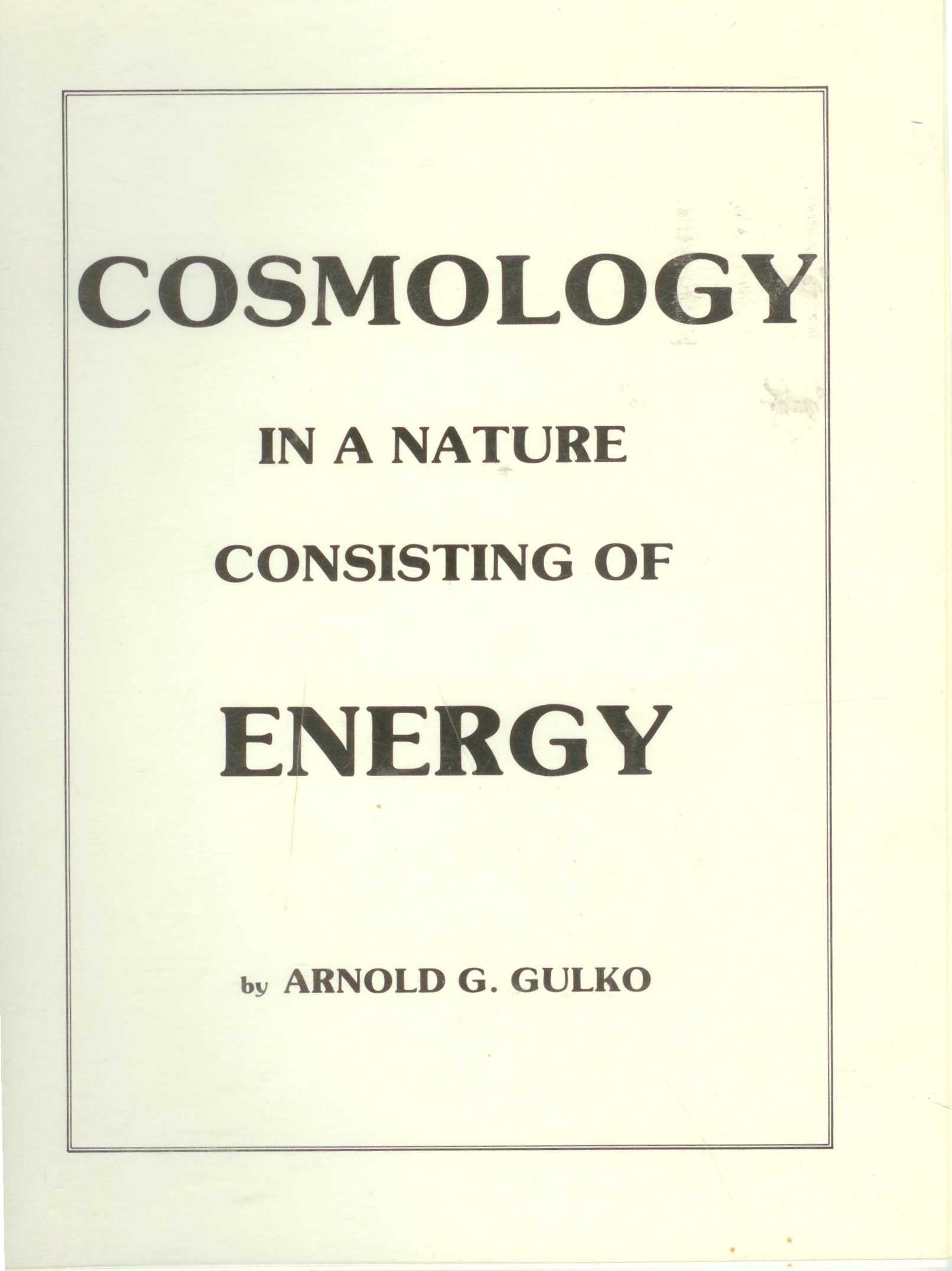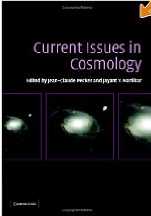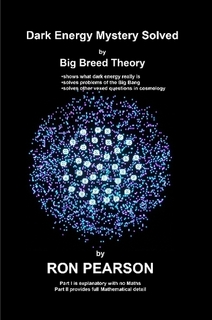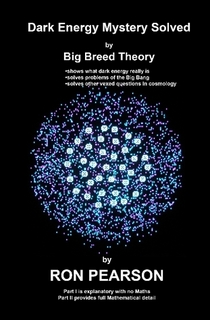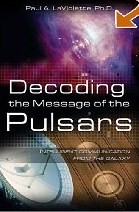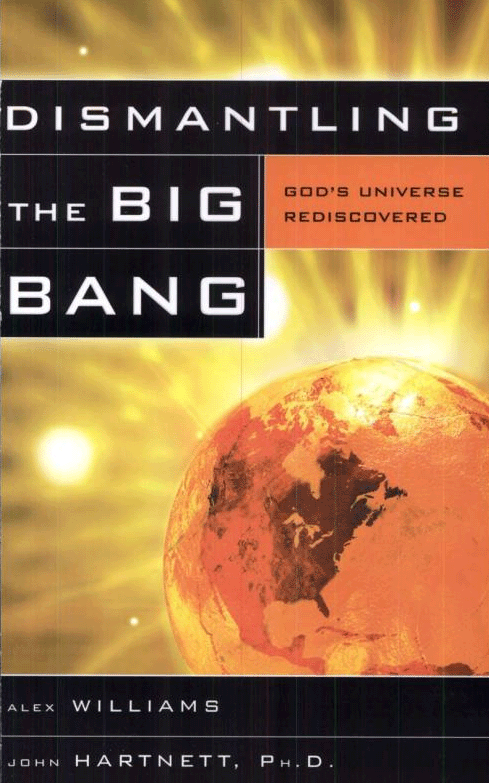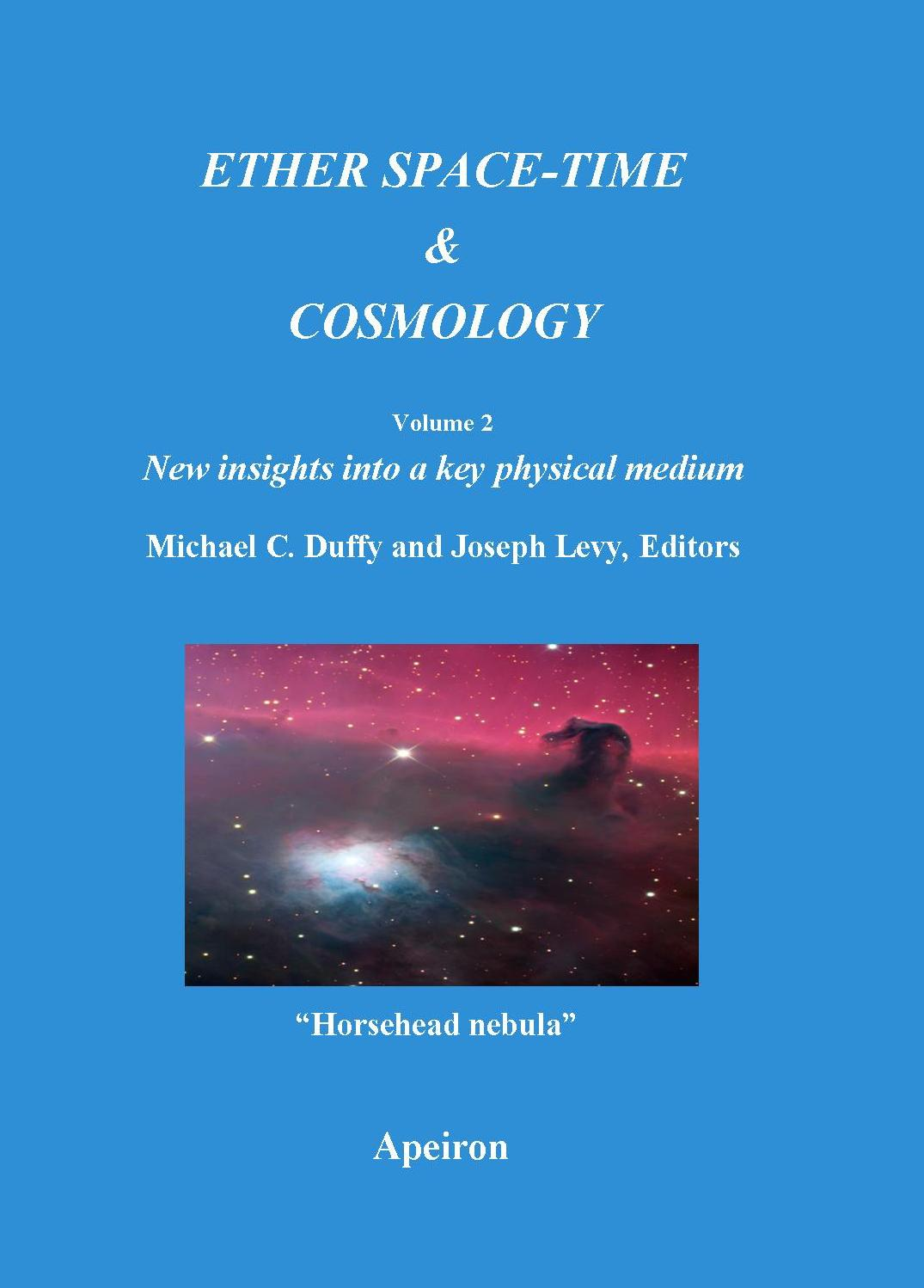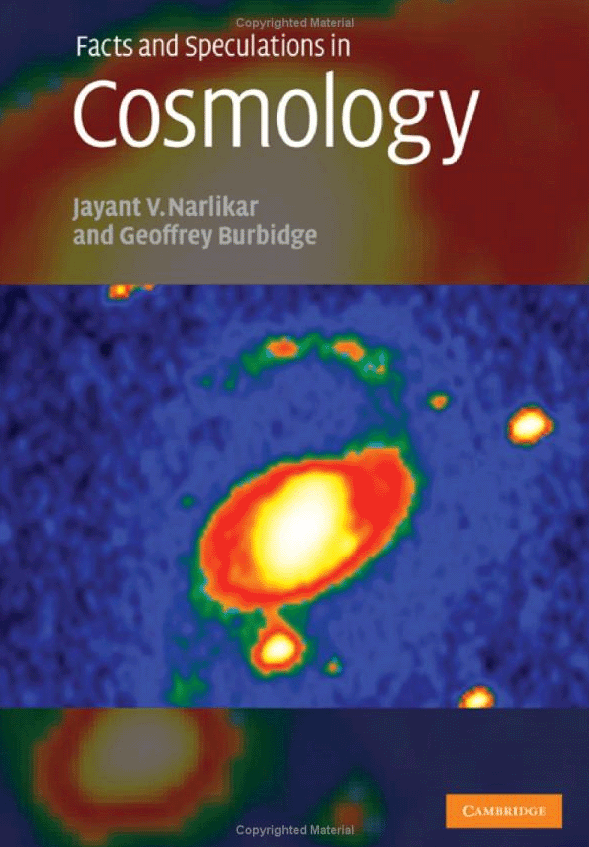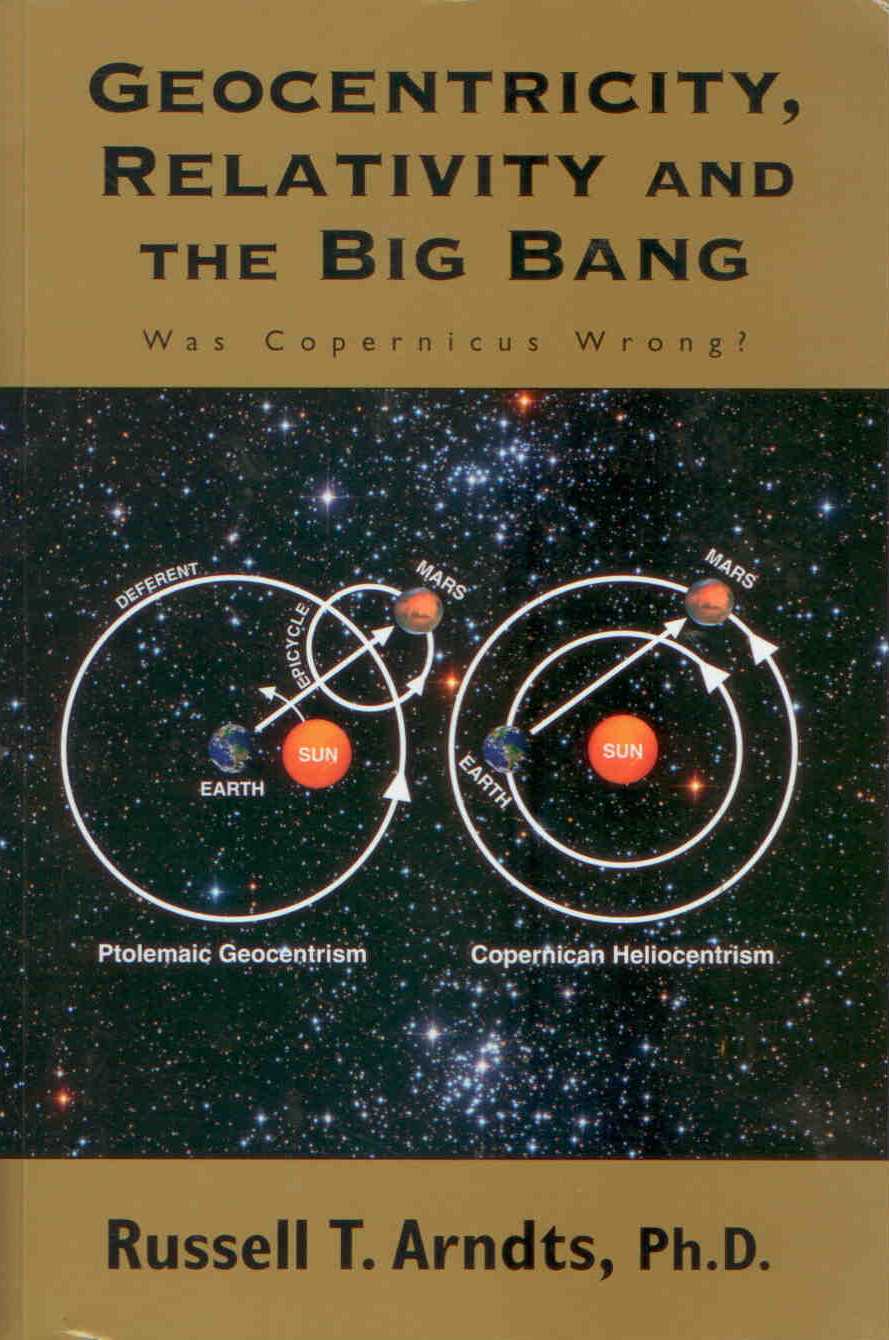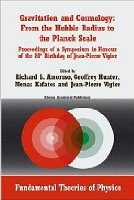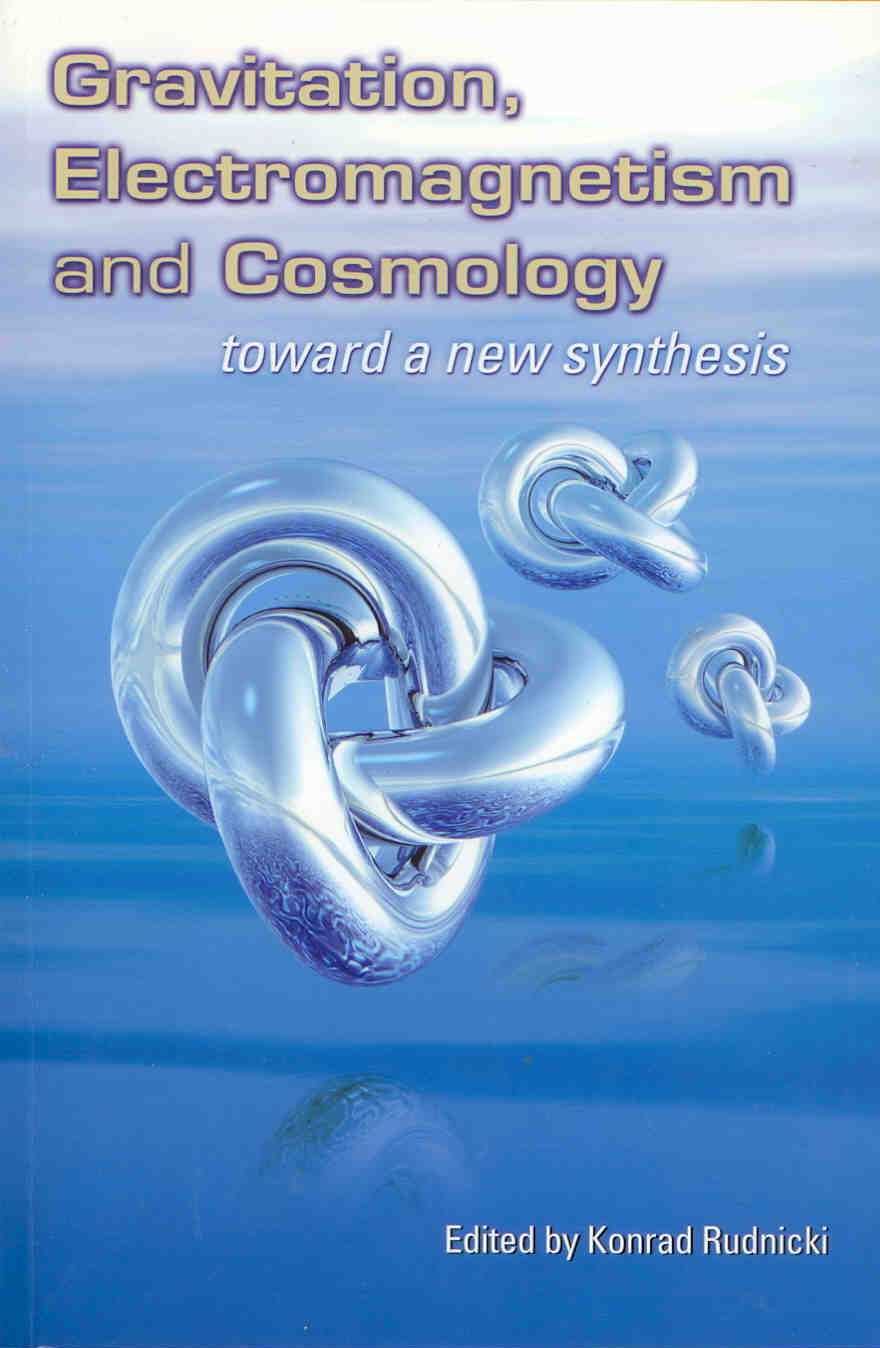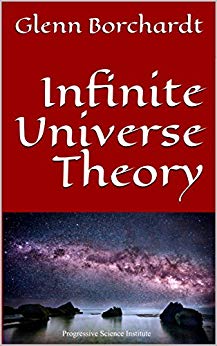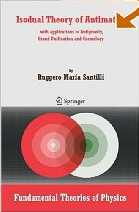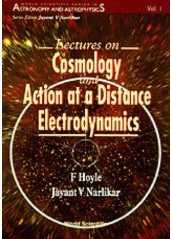(See right-hand panel for a full list of scientists, papers, and books)
Pages: 372
Publisher: Cambridge University Press
Year: 2000/2005
ISBN: 0521019265
ISBN: 978-0521019262
Review
"Professor Sir Fred Hoyle, Britain's greatest living astrophysicist...launches his most comprehensive attack against the Big Bang theory, in a book with the archly subversive title A Different Approach to Cosmology...when Hoyle makes a cosmic pronouncement, it is invariably worth hearing...Together with two other respected astrophysicists, Hoyle systematically reviews the evidence for the Big Bang theory, and gives it a good kicking...it's hard not to be impressed with the audacity of the demolition job...I can only hope that I possess one-thousandth of Hoyles' fighting spirit when I, like him, have reached my 85th year." The Sunday Telegraph
"The writing style is lively and personal, and the scientific arguments are written in such a way as to be accessible to upper-division undergraduate students in physics and astrophysics. The book is very well referenced and illustrated with suitable and approproate illustrations. Recommended for upper-division undergraduates, graduate students, and two-year technical program students." Choice
"This is a fascinating book, expressing the views of three scientists who choose to go against the conventional cosmological wisdom. It is extremely important for such skepticism to exist and for such books to be written." Physics Today
"The book is a serious and professional contribution to scientific cosmology." Sky & Telescope
"Throughout the last few decades, Fred Hoyle, Geoffrey Burbidge, and Jayant Narlikar have done the cosmology community a great service by developing and defending a serious alternative to Big Bang models of cosmic origins. A Different Approach to Cosmology is a summary of their work...by elucidating one of the hot Big Bang's competitors, the authors provide a good educational exercise for any graduate student interested in fundamental cosmology." Science
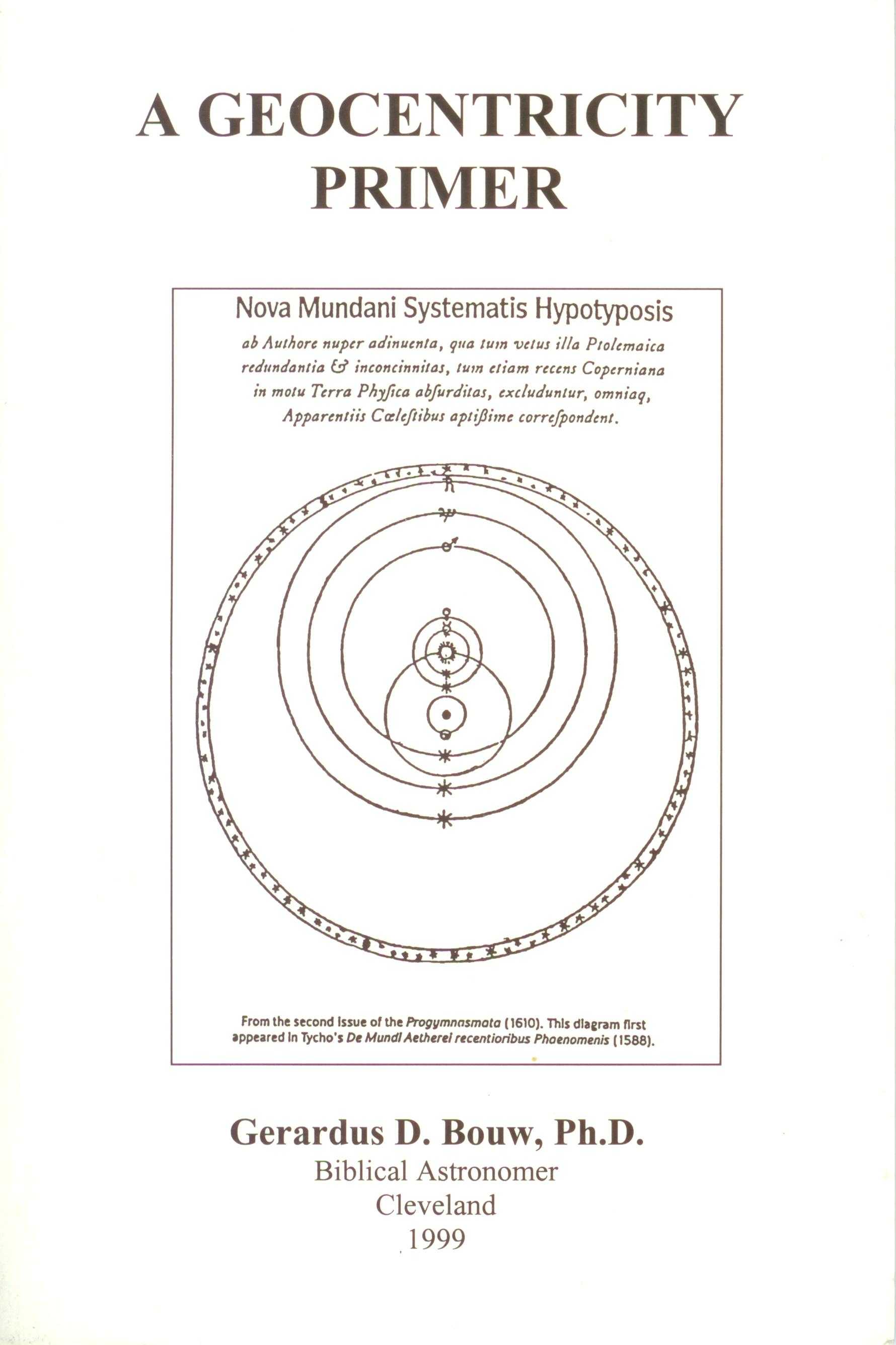
View count: 1
Pages: 530
Publisher: Aethron Press
Year: 1994
ISBN: 0966757106
ISBN: 978-0966757101
Websites: www.westworld.com/~srado www.aethro-kietics.com
From the Publisher
The text book of the 21th century
Praise for this Title:
Caroline Thompson - Department of Computer Science University of Wales, UK.
"I am not alone in wanting a return of the aether!! If you're prepared to devote serious time to the subject, and realise that what he's talking about is just a model, but one that does have some very interesting properties, Steven Rado has worked out the details of a mechanical model and you must read his book. I haven't yet finished it, but he gives one hope that we may some day learn to understand our Universe intuitively if we can first really understand the kinetic theory of gases. Don't worry, Rado will teach you, by means of careful analogies and beautiful pictures. Could this be how we shall be taught physics in the next century?"
Fred Walker - Electronic Engineer - Monterey, California , USA
"I have found your book on Aethro-Kinematics fascinating and difficult to put down for more than brief periods. In selfdefense, therefore, I have had to skim through parts of it. I have juist finished your "Epilogue, so that I can now put it down and get on with other necessary things, but I expect to return to it for further study and reference. as time goes on. -- Your scholarly, presentation has been informative and interesting in many details.
"There is no doubt that, our common idea of a universal aether containing dynamic vortices on every scale and thus accounting for all the mechanical events and relationships in the cosmos, provides a better and more promissinq . prospective for the physical sciences than the conventional ideas which now prevail. We can not know how long it will take for these new concepts to take hold, but when the revolution finally explodes, I am sure that your book and your ideas will have a prominent place in the vanguard."
William C. Mitchell - Institute for Advanced Cosmological Studies - Monterey, California, USA
"I received your book a couple of weeks ago and finally have had time to finish reading it. - It's just great. Your knowledge of science and the problems of "modern" science is absolutely overwhelming. Although I can't say that I'm as yet totally convinced of your wonderful Aethro-Kinematic theory, but you have certainly convinced me that you are on the right track. It seems there has to be a medium of transmission of "stuff" through space. Action-at-a-distance violates all our Earthly experience.
Of course I couldn't fully absorb your ideas in a single reading. I hope to read your book again in the relatively near future and get back to you with with more comment.
Bernard Nurnberger - Electrical engineer - Yokahama, Japan, Planet Earth
"My own test of my understanding is: does it work, can I do something with it, and is it basically simple? -- Aethro-kinematics as you explain it IS simple. I want to do something with it now.
"May I state that this book explains to me many phenomena with remarkable common sense. I want to put this precious knowledge to work. The planet needs help to shed the contamination brought about by this fire-society and their polluting fuels. Aethro-kinematics opens the door to new technologies. Your book also deserves mention in New Energy News, the monthly newsletter of the Institute of New Energy."
Bernard L. Feldman - Electrical engineer, inventor. - Watsonville, California, USA
"I have just started reading it and I am completely fascinated by your presentation. The least that can be said about your book is that Chapters 1-4 and 17 constitute a pedagogical masterpiece on modern physics abd the roots of its contradictions. Your review of classical and modern physics is the best of any I've ever read and I've read quite a few on modern physics."
Dr. Ing. J?rgen Schulz - Member of ISAAP - A-9544 Feld am See, Austria
"I went into the sink vortex model, the rotational gravitation hypothesis, which really got me hooked. Makes a lot of sense. But still left with the remaining question what causes the sink process and where the aether goes in the center of a mass, being converted into mass or energy or what - you are now leaving me with the additional problem of the tangential component of the aether on the surface of the earth, that has in my mind no basis of experimental evidence! Or does it? I hope you can solve my little problem. I'm looking forward to your response."
Pages: 560
Publisher: Cambridge University Press
Year: 1983/1986/1993/2002
ISBN: 0521793769
ISBN: 978-0521793766
ISBN: 0521412501
ISBN: 978-0521412506
ISBN: 052142352X
"This valuable graduate-student text is comprehensible and has many problems for students to solve." Sky and Telescope
'... the quality of the text is at the high level the author's reputation would suggest ??'. Astronomy & Geophysics
'... a really excellent set of lecture notes which add up to a very accessible text on what is often misrepresented as an extremely esoteric subject ... due to its clarity, straight-forward style, and scope, this book has long been a favourite of students.' Dominic Clancy, The Observatory
'The student can gain some early practice by looking at the examples presented here. They will also obtain a rigorous overview of the present observational data that will need to be incorporated into any model that wishes to displace present big bang cosmology.' Contemporary Physics
Pages: 294
Publisher: Basic Books
Year: 1997/2001
ISBN: 1568581890
ISBN: 978-1568581897
FOR NEARLY SIX THOUSAND YEARS of recorded history, humans have wondered how the world began, what is the ultimate nature of the matter it is made of, and what will be the fate of the universe.
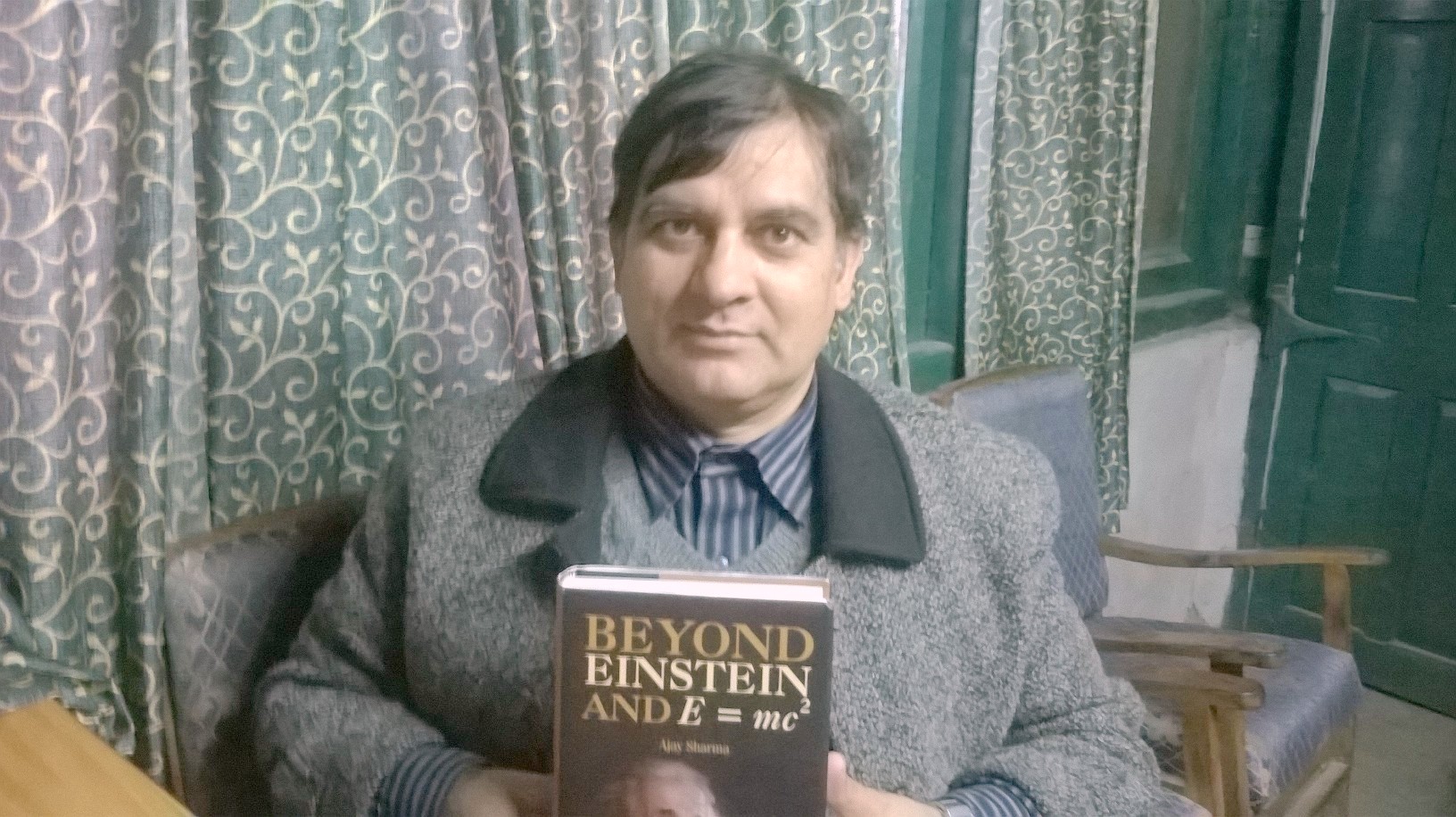
View count: 1
Pages: 546
Publisher: Cambridge International Science Publishing Ltd. Cambridge ENGLAND
Year: 2015
ISBN: 978-1907343315
Websites: www.AjayOnLine.us
Beyond Einstein and E=mc2
Publisher, Cambridge International Science Publisher, Cambridge, England)
Burn the candle of ‘doubt’ to get scientific light.
Should scientists be regarded above almighty GOD ?
(i) Einstein’s 1905 paper of Theory of Relativity was published in Annalen der Physik without any peer review by experts. So whatever Einstein wrote was published. Einstein took this opportunity to publish work of Galileo (1632), Poincare (1898), Lorentz (1892 ) , time dilation Larmer (1897 ) ,length contraction Fitzegerald (1889 ) etc. AS HIS OWN. Einstein scored goals without goalkeeper in playground. So the theory of relativity is not Einstein’s. In scientific language it is called plagiarism and in general sense THEFT in broad day daylight. Einstein called work of Galileo and Poincare as postulates or hypothesis ….. but these are accepted realities in the literature when Einstein published them.
(ii) Einstein’s derivation which leads to E=mc2 , also implies that WHEN A CANDLE BURNS ITS MASS MUST INCREASE. It is the biggest contradiction in science. Thus equation is derived in alternate way as dE=Ac2dm . Thus generalized equation is general equation and E=mc2 is its special case. A can be less, more or equal to unity.
(iii) In 1907 Einstein had also derived rest mass energy E(rme)=Mc2 . It is derived under condition when FIRST equation is zero, and last equation is E(rme)=Mc2. Thus we get OUTPUT without INPUT. It can be understood in analogous way as ……ground floor of the 10 storeyed building is demolished. Then according to Einstein’s logic, the remaining 9 storeyed building will FLOAT in air. Thus Einstein’s deduction is BASELESS.
(vi) When velocity of body or particle becomes comparable to that of light, then its mass increases. Then its heavier mass (or actual mass) must be taken in account. However in nuclear
chain reaction the velocity of neutrons is in relativistic region, so its mass must increase. But mass is taken as original mass. It is not justifies. Also E =mc2 cannot explain simultaneously the MASS DEFECT and BINDING ENERGY of deuteron. The generalized equation dE=Ac2dm can explain.
Pages: 384
Publisher: Inner Traditions
Year: 1995
ISBN: 0892814578
ISBN: 978-0892814572
Websites: www.etheric.com/LaViolette/LaViolette.html www.topsecrettestimony.com/Witnesses/AllWitnesses/DrPaulLaViolette/tabid/259/Default.aspx
The author begins by explaining this theory - a continually transmuting ether of existence, akin to the Dirac Sea of virtual particles in quantum mechanics. A theory that describes how matter can be created from fluctuations in chaotic flux, and links gravity and electromagnetic forces. He then continues by providing evidence of how this theory was known long ago, and what implications it has for science and our future.
It does not rely, as one reviewer put it, on the "tired light" cosmology. It, instead, creates a living framework for the universe in which the Doppler red shift could also, to my mind, be explained by Hadrons putting on weight as they get older. This would also explain the "high red-shift, low red-shift at the same distance anomaly".
Although some of the links to mythology verge on the "very tenuous", there does seem to be overwhelming evidence that our ancestors were more intellectually advanced than we are led to believe. Not least, the "instantly civilized" Egyptians, who appeared overnight with a complete socio-economic structure, fully developed written language and advanced scientific knowledge.
It is truly refreshing to find a mind that is not blinkered by the views of his peers and seeks to explore new pastures. Pastures that have not been specifically designed to keep the herd happy, and which the herd is equally scared to stray from.
If you are scientifically inclined, with an open mind and a desire to understand everything, then BUY THIS BOOK!
It may not give you all the answers, but it will certainly give you ideas... - Amazon
Pages: 446
Publisher: Cosmic Sense Books
Year: 2002
ISBN: 0964318814
ISBN: 978-0964318816
Websites: hometown.aol.com/wmitch8493/myhomepage/index.html
Gain an understanding of Big Bang Theory in a few short chapters.
Learn about its many flaws ? why you shouldn?t believe a word of it.
Then learn the true story of cosmology based on facts and logic.
From the Back Cover
A lucid description of Big Bang Theory is first presented. Following that, the long list of older flaws in that theory are reviewed, and some newly discovered additions to those are presented. The combined impact of those flaws forever destroys the credibility of a Big Bang. But, more importantly, an alternative theory that is based on astronomical data, proven science and logic is then presented.
Common sense denies the possibility of the accretion of matter required for the formation of new galaxies in a relativistically expanding Big Bang universe. In fact, the possibility of any appreciable expansion is denied. Nevertheless, astronomical observations of recent years show that new galaxies have been forming for many billions of years.
Astronomical observations also show existing galaxies are spewing enormous amounts of matter and energy into intergalactic space, providing evidence of their gradual death. However, due to gravitational attraction, that matter and radiation, combined with the hydrogen that pervades all of space, results in the continuous formation of new galaxies in violent swirling clouds of "gas and dust."
Those intriguing features reveal an ancient, ever-recycling, non-expanding universe containing galaxies of various ages, shapes and sizes. This new recycling universe cosmology (RUC), has been called "a masterpiece of research and synthesis."
In addition to references to source material throughout, included herein are several illustrations, appendixes that provide related background material and supporting mathematics, a comprehensive bibliography, and name and subject indexes.
This book succeeds Mitchell?s 1995 book, The Cult of the Big Bang, that was published with endorsements by allies in the struggle against Big Bang theory. Those allies included plasma physicist and cosmologist Anthony L. Peratt of the Los Alamos National Laboratories, astronomer and cosmologist Halton C. Arp of the Planck Institute for Astrophysics in Germany, and Professor Jayant V. Narlikar, director of the Inter-University Centre for Astronomy and Astrophysics of India.
Publisher: Cambridge University Press
Year: 1952/1960/1961
ISBN: B000WH3KWG
ISBN: B000WGW62M
ISBN: B000P7X44W
ISBN: B000Q9QYAK
ISBN: B000QA3W22
Pages: 278
Publisher: Cambridge University Press
Year: 2006
ISBN: 0521858984
ISBN: 978-0521858984
Pages: 224
Publisher: Bear & Company
Year: 2006
ISBN: 1591430623
ISBN: 978-1591430629
Websites: www.etheric.com/LaViolette/LaViolette.html www.topsecrettestimony.com/Witnesses/AllWitnesses/DrPaulLaViolette/tabid/259/Default.aspx
A new interpretation of nearly 40 years of interstellar signals and the prophetic message they contain
- Contains extensive analysis of pulsar data, revealing new ideas about the origins and functions of pulsars
- Provides proof of an extraterrestrial communication network
- Includes information about the formation of crop circles and force-field-beaming technology
In 1967, astronomers began receiving and cataloging precisely timed radio pulses from extraterrestrial sources, which they called pulsars. These pulsars emit laserlike radio beams that penetrate through space much like searchlight beams. Paul LaViolette, who has been researching pulsars for over 25 years, shows that while these pulsars have long been assumed to be spinning stars, the true nature of these radio sources has been grossly misunderstood.
In Decoding the Message of the Pulsars, LaViolette shows that pulsars are distributed in the sky in a nonrandom fashion, often marking key galactic locations, and that their signals are of intelligent origin. Using extensive scientific data to corroborate his theory, he presents evidence of unusual geometric alignments among pulsars and intriguing pulse-period relationships. Equally compelling is the message LaViolette contends is being sent by these extraterrestrial beacons: a warning about a past galactic core explosion disaster that could recur in the near future.
Pages: 356
Publisher: Creation Book Publishers
Year: 2005
ISBN: 0890514372
ISBN: 978-0890514375
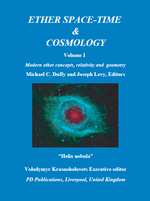
View count: 1
Pages: 438
Publisher: PD Publications, Liverpool, UK
Year: 2008
ISBN: 1873694105
Websites: www.physicsfoundations.org
Researches undertaken during the last 20 years have confirmed that space possesses physical properties even where it is devoid of ordinary matter. In addition to the well known properties of permittivity, permeability and the ability to transmit electromagnetic waves, other features have been more recently associated with the nature of space. These include the Casimir Effect and a significant amount of energy. This medium, devoid of any trace of ordinary matter, is usually referred to as "Physical Vacuum", "Plenum" or "Cosmic Substratum" along with other appellations. Despite the veil of equivalent terms, these names obviously refer to the Ether, a medium conceived in antiquity, which received much attention from Science between the 17th and early 20th centuries. Today it is commonly understood throughout the academic community that Einstein excluded once and for all the ether from modern physics with his Special Theory of 1905. There is a widespread, unjustified assumption that ether is conceptually incompatible with Relativity, though Einstein developed an equivalent concept in the context of the General Theory and his later work. We may add that Einstein?s ether concept has inspired many modern physicists though others follow another direction of thought. The aim of this first volume of papers is to examine the different paths by which the modern ether concept has been developed and to highlight the part it plays in major departments of 21st C physics. The evidence for its existence is reviewed, and it is hoped, widespread misconceptions concerning ether are corrected. It is anticipated that the emerging modern concept of ether will play a fundamental part in the development of 21st C physical science. - Back cover
A book dealing with experimental and theoretical studies devoted to the exploration of the modern ether concept, evidence of its reality and implications for modern physics.
Contents:
-5- Editor's Foreword
-7- Introduction
-13- Ether as a Disclosing Model, Michael C. Duffy
-47- Einstein's New Ether 1916-1955, Ludwik Kostro
-69- Basic Concepts for a Fundamental Aether Theory, Joseph Levy
-125- Aether Theory and the Principle of Relativity, Joseph Levy
-139- Ether Theory of Gravitation, Why and How, Mayeul Arminjon, Laboratoire Sols, Solides, Structures, Risques, CNRS & Universite de Grenoble, BP 53, F-38041, Grenoble Cedex 9 France
-203- A Dust Universe Solution to the Dark Energy Problem, James G. Gilson, school of mathematical sciences, Queen Mary University of London, Mile End Road, London E14NS, United Kingdom E-mail: j.g.gilson@qmul.ac.uk
-217- Eddington Ether and Number, Raul A. Simon, LAMB, Santiago Chile
-257- The dynamical Space-time as a Field Configuration in a Background Space-time, A. N. Petrov, Department of Physics and Astronomy, University of Missouri,-Columbia, Columbia MO 65211, USA and Sternberg Astronomical Institute, Universitetskii pr., 13 Moskow 119992 Russia E-mail: anpetrov@rol.ru
-305- Locality and Electromagnetic Momentum in Critical Tests of Special Relativity, Gianfranco Spavieri, Jesus Quintero, Arturo Sanchez, Jose Ayazo, & Georges T. Gillies, Department of Mechanical and Aerospace Engineering, University of Virginia, PO Box 400746, Charlottesville, Virginia 22904, USA E-mail: gtg@Virginia.edu
-357- Correlations Leading to Space-time Structure in an Ether, J. E. Carroll, Engineering Department, University of Cambridge, CB2 1PZ, United Kingdom, E.mail: jec1000@cam.ac.u
-407- Reasons for Gravitational Mass and the Problem of Quantum Gravity, Volodymyr Krasnoholovets
Pages: 488
Publisher: Apeiron
Year: 2009
ISBN: 0973291184
ISBN: 978-0973291186
Websites: www.physicsfoundations.org/Ether_spacetime/introduction_2.html
This second volume, as the first did, presents articles written by experienced physicists dealing with different aspects of the ether concept. One of the objectives of this series of books is to progressively disclose its properties. The introduction of the ether as a main actor in physical processes, will resolve a number of paradoxes in 20th century physics which arose because of its dismissal.
Ether Space-Time & Cosmology is a development of the Physical Interpretations of Relativity Theory conferences, which began in 1988, in London, and which now take place in London, Moscow, Calcutta and Budapest. Details of these conferences, including names and addresses of contacts and sponsors, are given on the PIRT web site http://www.physicsfoundations.org/.
Pages: 296
Publisher: Cambridge University Press
Year: 2008
ISBN: 0521865042
ISBN: 978-0521865043
Publisher: Lindquist Books
Year: 2008
ISBN: 0981458408
ISBN: 978-0981458403
Websites: www.thetruthwillwin.com
The notion that the earth is motionless and is at the very center of the universe was proven to be false centuries ago. Or was it? According to scienctist Russell Arndts, the idea of a geocentric universe should never have been abandoned. The Michelson-Morley experiment of 1887 - one of the most famous and important experiments in the history of physics - proved beyond question that the earth is staionary. The author contends that big bang cosmology and Einstein's theory of relativity were invented to cover up the results of that experiment. And they have led science in the wrong direction - a belief that the universe is bigger and older than it really is.
This book will make you reexamine everything you thought you knew about the universe. It will help you answer the "light from distant stars in a young universe" problem. As this book makes clear, the earth is not just a speck of dust orbiting an inconsequential star. It is the very centerpiece of God's creation.
Pages: 557
Publisher: Springer
Year: 2002
ISBN: 1402008856
ISBN: 978-1402008856
Websites: www.yorku.ca/ghunter
Pages: 177
Publisher: C. Roy Keys Inc. (Apeiron)
Year: 2001
ISBN: 0968368964
Websites: en.wikipedia.org/wiki/Konrad_Rudnicki
Editors' Introduction
Fritz Zwicky, the great 20th century astronomer, astrophysicist and theoretical physicist, also dealt with methodology of research, which is considered to be one of branches of the philosophy of science. Zwicky, unlike most philosophers working in this area, not only discussed methods used by others but applied his methodological ideas to a new practical approach in his highly successful scientific research. This approach helped him to discover new objects and new facts. His activity in the fields of the exact sciences and of philosophy in science formed an integral whole. He advocated taking all possible, even exotic hypotheses into consideration, and never adhering only to a single hypothesis. In his Morphological Astronomy he wrote the following words, which should be taken as a fundamental principle in all research:
If rain begins to fall on previously dry areas on the earth, the water on the ground will make its way from high levels to low levels in a variety of ways. Some of these ways will be more or less obvious, predetermined by pronounced mountain formations and valleys, while others will appear more or less at random. Whatever courses are being followed by the first waters, their existence will largely prejudice those chosen by later floods. A system of ruts will consequently be established which has a high degree of permanence. The water rushing to the sea will sift the earth in these ruts and leave the extended layers of earth outside essentially unexplored. Just as the rains open up the earth here and there, ideas unlock the doors to various aspects of life, fixing the attention of men on some aspects while partly or entirely ignoring others. Once man is in a rut he seems to have the urge to dig even deeper, and what often is most unfortunate, he does not take the excavated debris with him like the waters, but throws it over the edge, thus covering up the unexplored territory and making it impossible for him to see outside his rut. The mud he is throwing may even hit his neighbours in the eyes, intentionally or unintentionally and make it difficult for them to see anything at all.
This volume, devoted to the problems of relativity, gravitation and related issues in physics, presents papers delivered and/or discussed during the conference ?Redshifts and Gravitation in a Relativistic Universe? held in Cesena on September 17-20th 1999. In a way, this conference represents a response to Zwicky?s method, outlined above. Its main aim was to serve as a forum for ideas and theories that go against the mainstream of science. Some of the theories are already cast in their final form; some are just rough ideas still undergoing development. Not all of them will prove correct, just as not all of the mainstream theories are wrong. Only reality is an absolute truth, while our theories have only approximate validity. The great German thinker Johann Wolfgang von Goethe wrote: not distinguishing between reality and theory is like not distinguishing between a building and its scaffolding. Theories are tools, not objects of scientific investigation, but indispensable tools. Only a wide variety of tools can enable us to carry out such a complicated task as scientific research.
In addition, a wide variety of observed phenomena have to be taken into consideration in a properly organized scientific investigation. Some phenomena which are seldom mentioned by others?such as quantization of redshifts?are discussed in this volume.
Some of the papers are presented here in more or less the same form in which they were delivered during the conference. Some were reworked more recently and take a final form different from the presentation. No minutes of the extensive discussion in the conference auditorium or the more lively discussions that continued during breaks and around dinner tables were recorded. In some cases the discussions are reflected in the final shape of the papers. Two of the papers included here were not presented as such during the conference, but their content was mentioned and taken under consideration during the debate. This volume therefore should not be regarded as a formal proceedings of the Cesena Conference, although it does fairly reflect the substance of the event.
In his contribution A.K.T. Assis proposes the principle of physical proportions, according to which all laws of physics can depend only on the ratio of known quantities of the same type. An alternative formulation is that all universal constants of physics (G, c, Planck?s constant, Boltzmann?s constant, etc.) must depend on cosmological or microscopic properties of the universe. There is a discussion of laws satisfying this principle and of other laws which do not follow it, implying that the corresponding theories must be incomplete. The author shows how to implement this principle by means of his theory of Relational Mechanics, as set out in the book of the same title (Apeiron, Montreal, 1999).
The paper presented by H. Broberg is based on the equivalence between gravitation and acceleration, initially suggested by Einstein. This introduces a new geometric approach to quantum gravity, the missing link to unification, extended to a discussion of energy flows in the vacuum as the key mechanism of the gravitational process. His ideas also relate to string theory in a scenario where the extra dimension, representing the ?thickness of the line,? can be allowed to exist from the Planck length up to the Hubble scale.
An alternative picture of the structure of galaxies is proposed in the paper by Marek Biesiada, Konrad Rudnicki and Jacek Syska. The authors discuss the possible explanation of dynamical properties of galaxies with the theory of dilatonic balls using six-dimensional space.
In the paper ?Electromagnetism and Cosmology? by Edward Kapu?cik a rather convincing argument is given that the correct unification of electromagnetism and gravity should start from some elementary and basic proto-fields which are neither electromagnetic or gravitational fields. The presently observed division of fundamental interactions into gravitational and electromagnic must be achieved by constructing composite fields from the proto-fields. In addition to the field equations, the gauge conditions also express physical laws and determine these composite fields. The last statement contradicts the point of view commonly adopted, which treats the gauge fields as auxiliary quantities.
Two papers by F. Selleri show that transformations of space and time between inertial systems exist which are almost empirically equivalent to the Lorentz transformations. They contain a free parameter e1, the coefficient of x in the transformation of time. He shows that Michelson type experiments, aberration, occultation of Jupiter satellites, and radar ranging of planets are insensitive to the choice of e1. An exception is represented by experiments in slowly accelerated frames, e.g., those concerning the Sagnac effect. The best choice emerging from Selleri?s work is where the parameter e1 = 0, i.e., a theory different from Special Relativity.
One of the goals of the Cesena conference was to find common ground among the dissidents beyond their certitude that some mainstream models are wrong. That proved surprisingly difficult, and the discussions showed why?we differed about which fundamental starting points were a valid basis for building models. Should model-building be driven my math or by physics? Are singularities allowed by reality? Can matter and energy be created or destroyed? Must the causality principle be respected? And so forth. One session on the last day of the conference was devoted to a discussion of these points, and we found that no unanimity existed about any of them. That led directly to the contribution by Van Flandern, ?Physics has its Principles,? which attempts to examine several such fundamental principles and show the consequences in each case of making a wrong assumption about its applicability or non-applicability. Whether or not this initial effort brings dissident views closer, it has certainly highlighted the points that must be resolved for any hope of a convergence of models and viewpoints in the future.
Many physicists point to the proper functioning of the International Atomic Time system (TAI) in order to support the postulate of Special Relativity Theory about the one-way isotropy of light velocity in every inertial system, which has never been demonstrated. Contrary to this view, Manaresi demonstrates that the proper functioning of the TAI system does not imply the one-way isotropy of light on the moving Earth. This means that the second postulate of Special Relativity still remains merely conventional.
Astronomical observations show that some fundamental cosmic properties come in discrete values. The ratio of observed properties, such as redshift or mass, for example, yields a ubiquitous factor of 1.23. In the paper by A. and J Rub?i? and H. Arp in this volume the properties of fundamental particles such as leptons and quarks are examined. The surprising result is that they also obey this ?quantization? rule. While there is no current explanation, these empirical results point to similar physical laws which extend from the smallest to the largest entities in the universe. This may lead to a physical understanding of redshift quantization.
A very straightforward paper by K. Rudnicki, W. God?owski and A. Magdziarz presents a statistical elaboration of a very small sample of objects within the Iwanowska lines of galaxies and globular clusters. It shows that globular clusters, even located together with galaxies on the same lines, do not show redshift periodisation, whereas the galaxies do show the periodisation.
B. Bligh starts with some basic notions of thermodynamics to expose some of the errors made by cosmologists. Thermodynamic calculations require an energy balance. He then presents calculations on the Hot Big Bang Theory using data provided by cosmologists. The results are presented in a table and graphs which show that the Big Bang Theory cannot be true. Mr. Bligh also explains that thermodynamic calculations are most easily done with the aid of a temperature-entropy diagram for hydrogen, a method that is demonstrated in detail in his book The Big Bang Exploded!
Lastly, the paper by Cardone and Mignani deals with a problem that has been the subject of long-standing debate in the literature, namely the possibility of a breakdown of local Lorentz invariance (a subject revived in recent years, e.g., by S. Coleman, S.L. Glashow and R. Jackiw). In their paper, Cardone and Mignani report the preliminary positive results of an experiment which seems to evidence a DC voltage across a conductor induced by the static magnetic field of a coil. This intriguing finding ought, of course, to be confirmed by further independent tests, aimed at excluding possible gravitational effects, among the other things.
Pages: 324
Publisher: Progressive Science Institute, Berkeley, CA
Year: 2017
Websites: www.scientificphilosophy.com/
Infinite Universe Theory presents the ultimate alternative to the Big Bang Theory and the common assumption that the universe had an origin. Author Glenn Borchardt starts with photos of the “elderly” galaxies at the observational edge of the universe. These contradict the current belief that the universe should have increasingly younger objects as we view greater distances. He restates the fundamental assumptions that must underlie the new paradigm. Notably, by assuming infinity he is able to adapt classical mechanics to “neomechanics” and its insistence that phenomena are strictly the result of matter in motion. He shows in detail how misinterpretations of relativity have aided current flights of fancy more in tune with religion than science.
Borchardt demonstrates why only Infinite Universe Theory can provide answers to questions untouched by currently regressive physics and cosmogony. His new modification of gravitation theory gets us closer to its physical cause without calling upon attraction or curved spacetime or “immaterial fields.”
This is the book for you if you have doubts about the universe exploding out of nothing and expanding in all directions at once, that the universe has more than three dimensions, or that light is a massless wave-particle that defies the Second Law of Thermodynamics. Borchardt has put forth a solid case for an Infinite Universe that extends in all directions and exists everywhere and for all time.
“What a great read! Thanks so much for a book full of great ideas. I love the Q&A format; it’s very satisfying to have good answers to clearly stated questions.” -Rick Dutkiewicz
“Truly brilliant.” -Jesse Witwer
“A radical, daring, and innovative demolition of regressive physics, from the creation of ‘something out of nothing’ to the ‘God Particle.’” -William Westmiller
"Glenn Borchardt's book uses the hammer of Infinity to explain and destroy the junk theories that plague 'Official' physics today. This is a book that should be used in college courses, to give students a basic understanding of how physics is done. Physics has 'gone off the rails' for a century and it is books like Borchardt's that will return physics from its current unscientific and anti-materialist base and back on to a scientific and materialist road." -Mike Gimbel
“What a fascinating read!” -Juan Calsiano
Pages: 329
Publisher: Springer
Year: 2006
ISBN: 1402045174
ISBN: 978-1402045172
Websites: www.i-b-r.org www.scientificethics.org
Antimatter, already conjectured by A. Schuster in 1898, was actually predicted by P.A.M. Dirac in the late 19-twenties in the negative-energy solutions of the Dirac equation. Its existence was subsequently confirmed via the Wilson chamber and became an established part of theoretical physics.
Dirac soon discovered that particles with negative energy do not behave in a physically conventional manner, and he therefore developed his "hole theory". This restricted the study of antimatter to the sole level of second quantization.
As a result antimatter created a scientific imbalance, because matter was treated at all levels of study, while antimatter was treated only at the level of second quantization.
In search of a new mathematics for the resolution of this imbalance the author conceived what we know today as Santilli?s isodual mathematics, which permitted the construction of isodual classical mechanics, isodual quantization and isodual quantum mechanics.
The scope of this monograph is to show that our classical, quantum and cosmological knowledge of antimatter is at its beginning with much yet to be discovered, and that a commitment to antimatter by experimentalists will be invaluable to antimatter science.
Pages: 139
Publisher: World Scientific Publishing Company
Year: 1996
ISBN: 981022558X
ISBN: 978-9810225582

